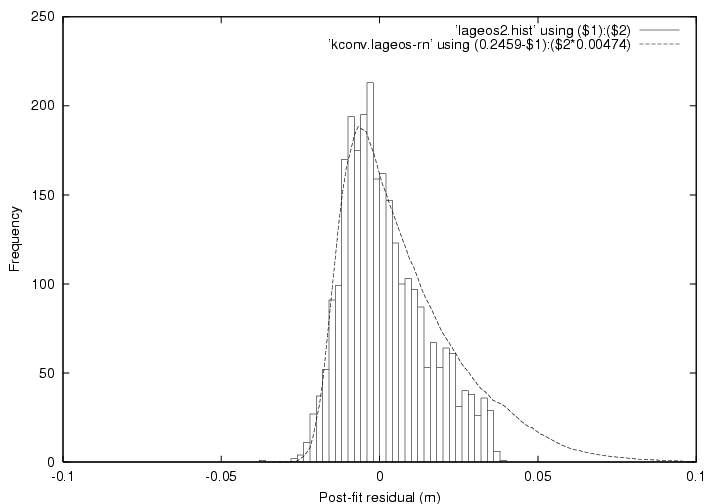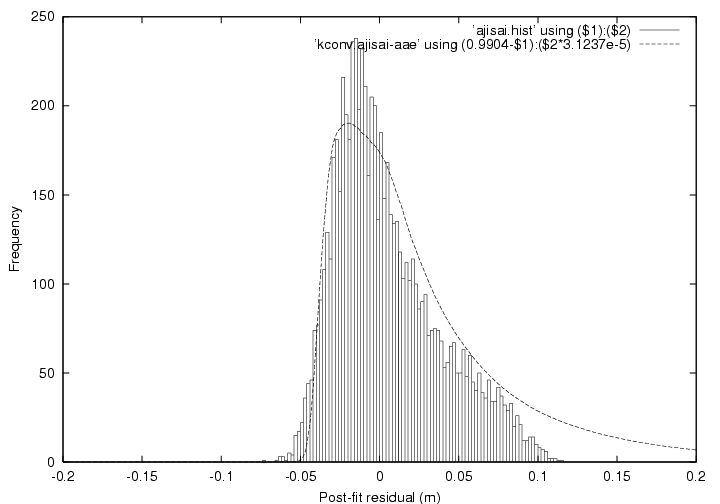
As one of the "tiger team" projects, we tried to compare the range residual with the target model using Keystone data as G Appleby did with Herstmonceux 7840 data. Keystone stations have an observation policy to control the return signal strength by keeping the return rate low. However, this policy is not as strict as Herstmonceux, so the detection level is considered to be sometimes slightly above single-photon.
Thanks to F Katsuo, CRL/Tokyo, we got a full-rate data set
of Koganei 7328, one of the Keystone stations, where a C-SPAD is used.
From its range data to a ground target, the raw data shows the following
single-shot profile.
They usually apply 2.5-sigma criteria for noise clipping, but
the whole profile is shown here.

Firstly, this calibration profile centred at 229803 ps two-way
(=mean after iterative 2.5-sigma rejection) was convolved
with Lageos response
function by R Neubert (GFZ), then the dashed curve below
is a modelled distribution
for an ideal single-photon condition (zero pe). This has to be compared
with a histogram of range residual that were derived from the Lageos-2
full-rate data (5 passes) using RGO software "solve" for data reduction.
To fit the modelled curve with the residual histogram,
we solved for two parameters, adjusting the y-axis scale and
the x-axis slide.
The two agreed reasonably well --- the scattering rms was 13 mm for the actual
residuals compared with 14 mm for the model after iterative 2.5-sigma clipping.
This result indicates that the Koganei station operated nearly around the
single-photon level, maybe slightly higher than that because of the slight
narrower width of the residuals.
By investigating a clipping point where the histogram profile is
chopped in tail, we also expect they are applying the 2.5-sigma data clipping
procedure iteratively [1], not just once or twice.
The x-axis sliding parameter was optimised as 0.2459 m.
[1] Later, this procedure was confirmed by F Katsuo.

We also applied a similar procedure to its Ajisai data set.
The calibration system profile was convolved with T Otsubo's Ajisai
response function,
and then the product was compared with the Ajisai full-rate
residual data (5 passes) via the two paramter adjustment.
The comparison result below showed a significant difference between
the model (scattering rms = 34 mm after iterative 2.5-sigma clipping)
and the actual residuals (scattering rms = 29 mm) in their width
though the "best-fit" curve may seem not so bad
due to the height scale adjustment.
The most likely reason of
this discrepancy is that the station
sometimes observed higher than the single-photon level.
However, compared with other "multi-photon" SPAD stations
like Graz (single-shot rms = 10 to 30 mm)
and Mt Stromlo (rms = 10 to 15 mm), Koganei is
apparently keeping a lower energy level for detection.

Throughout Herstmonceux and Koganei cases for Lageos and Ajisai, Lageos result from Koganei is the only one that gave a good agreement between the model and the residuals in their "leading edge" about which S Riepl (Wettzell) pointed out at Firenze colloquium. We don't know why at the moment.
See Also:
T. Otsubo's Ajisai response function
Tiger team homepage